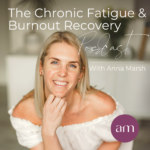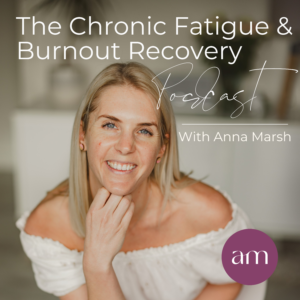
Shownotes
In this episode Anna explains why blood sugar regulation is essential for anyone who is experiencing and looking to recover from fatigue. She discusses the importance of blood sugar control for nervous system regulation. She highlights discerning signs that blood sugar imbalances could be a problem for you and how to use glucose monitoring and dietary changes to bring blood sugar into better balance.
Useful links:
Website: https://annamarsh.co.uk/
Instagram: https://www.instagram.com/anna_marsh_nutrition/
Fatigue Recovery Quiz: https://app.annamarsh.co.uk/quiz
Blood Sugar Balance and Fatigue
Welcome back to another episode of the chronic fatigue and burnout recovery podcast. I am your host Anna Marsh, functional medicine and trauma-informed nutritional therapist and chronic fatigue syndrome, recoverer or survivor; not quite sure, which is the best one to say survivor sounds very dramatic, and recoverer doesn’t sound quite slick. So, either way, I have recovered from chronic fatigue syndrome, and I’m here today with you to talk about blood sugar and fatigue.
In today’s episode, I’d like to cover what blood sugar got to do with chronic fatigue. Why is it so important? Here’s a bit of a spoiler alert; it is very important. Then I also want to cover signs of imbalanced blood sugar, how to begin to balance your blood sugar, and factors that will influence your blood sugar control. So let’s dive straight in.
We can talk about what blood sugar has to do with chronic fatigue. Ultimately, fatigue results from the inability to produce enough ATP or energy to meet the body’s needs. As the body’s energy currency, there are various mechanisms by which our ATP production can be influenced.
Blood sugar dysregulation is one of them. So if you are experiencing changes in your blood sugar, if you think that blood sugar could be a problem for you, I always check with all of my clients, even if I think their blood sugar is absolutely fine. Let’s check because it’s low-hanging fruit. It’s something really practical and actionable that you can address.
If it’s a problem for you, we want to nip it in the bud because it is something that will impact your body’s ability to produce energy. The reason is that food is fuel, and we get food or fuel from the proteins, fats, and carbohydrates in our diet. The brain needs glucose. A lot of fatigue is brain fatigue. The brain feels tired, and this has low brain energy.
Yes, sometimes the muscles or the metabolic system can feel tired and lacking in energy, but I know when I was experiencing chronic fatigue syndrome, there were days when my muscles and my body felt like they were okay; they could do stuff. But my brain just felt tired and didn’t want to do anything. Of course, there were also days when I just had heavy, tired muscles and a heavy brain and didn’t want to do anything. But brain energy and good and healthy brain function are important for our fatigue recovery.
Therefore, when we eat food and our diet, that food needs to be converted into glucose. For example, we can use amino acids from proteins to make glucose, which could supply the brain with energy. Or we can make ketones if we follow a ketogenic diet, which can supply the brain with energy.
But at the end of the day, the brain’s preferred fuel source is glucose. That doesn’t mean the more sugar or glucose we eat, the better. But we need to get that glucose across the blood-brain barrier and into the brain and the brain cells so that the brain can use it as energy.
And part of that process requires good blood sugar control because if blood sugar is too high, we get poor brain glucose penetration, which means that we’ve got a lot of glucose in our bloodstream. Still, we cannot penetrate the blood-brain barrier and get that glucose into the brain cells, where it’s required to make energy and ATP. So more is not better but what we want to do is we want to control glucose within a narrow range.
I’ll tell you about that range. Specifically, I advise my clients that it is between 4 and 6.3 millimoles per litre. If you’re using a different set of units, you’ll need to do the conversion for those units. That means the blood sugar may increase after we eat a meal. We digest the carbohydrate in that meal, it travels from the gut into the bloodstream, and we’ll experience an increase in blood sugar after we eat.

But two hours later, two hours after we’ve eaten, we want that blood sugar to maybe have peaked at about 45 minutes, one hour after eating, and that peak should not exceed 6.1, 6.3 millimoles per litre. And we should have it back down to baseline by about two hours after a meal, and the baseline would be whatever it was before you ate. So if your blood sugar was 4.5 before you ate, maybe it will be good to be around 4.5 after two hours after you’ve eaten your meal, so that’s the narrow range we’re looking for. If blood sugar is going too high, there are going to be a lot of consequences.
If blood sugar goes higher than seven, that would be defined as hyperglycemia, and that’s when we typically start to see poor brain penetration, although arguably, it could happen at lower levels. We’re also starting to see an increase in the need for insulin, which can lead to type two diabetes over time. Still, it can also increase inflammation in the body, which will not support fatigue recovery and good energy levels.
But on the other side is what happens if blood sugar goes too low. If your blood sugar drops too low, maybe you’re not eating enough, maybe you’re exercising too much. This will probably be for those still physically active but very tired.
So under-eating or over-exercising for how much you’re eating, or just eating erratically, skipping meals, or eating the wrong types of food, can sometimes cause blood sugar to go very high and maybe crash very low. When blood sugar crashes too low, the body panics and the body can become stressed. We can get increases in stress hormones like adrenaline and cortisol, and that is dysregulating the nervous system.
You can do all the breathing exercises and somatic practices that you like. Still, suppose your blood sugar is on a roller coaster ride. In that case, it’s going to feel very, very challenging, probably almost impossible, dare I say, for you to experience a very calm and settled and regulated nervous system because your window of tolerance is going to be very narrow if your blood sugar is crashing.
So the goal here is that we want to have stability. Yes, we will experience high blood sugar and lows as we eat throughout the day, but we want to minimize the impact of those highs and lows because we want to minimize poor brain glucose penetration. We want to ensure we’re not producing too much insulin to have good insulin sensitivity of the cells to take up the glucose and get it into the muscle tissue where we can use it.
We also want to ensure we’re not riding that roller coaster ride of highs and lows and then producing a lot of stress hormones because that can also be just regulating our sex hormones, thyroid hormones, and sleep for inflammation in the body. All of these things would be potentially influenced by these blood sugar highs and lows. Hopefully, I understand why blood sugar regulation is crucial for fatigue recovery.
Now I’d like to talk about the signs that you may have some imbalanced blood sugar. Generally speaking, there are two patterns that I typically tend to see with my clients. The first pattern, which I’ll refer to as pattern A, is the low blood sugar type.
This is often created when there is erratic eating, when somebody has a lot of stress, or just eating an imbalanced diet. There may be difficulty waking up in the morning, and maybe no appetite often because stress levels are very high. They may experience dips in energy during the day.

Often they’ll lose function before meals, so for example, they may experience poor mental function, fatigue, difficulty focusing and concentrating, maybe feeling a little bit hangry, and then they’ll eat something and feel much better. They may feel energized after meals but crash a little later, about three or four in the afternoon, have those typical afternoon munchies and afternoon cravings, and may be irritable and, at times, lightheaded. They may have a lot of cravings for sweet things.
They may find it difficult to sleep through the night because possibly low blood sugar increases their stress hormones, waking them up. That would be the first kind of pattern. Maybe there’s an opportunity for you to think, “Do I experience any of these things?” The next pattern, which we’ll call, pattern B, would be the high insulin type.
This is often created when somebody has just been eating a diet which is too high in carbohydrates for too long. Perhaps they’ve been under stress for a long time and are quite depleted, maybe from an adrenal gland perspective. This type of person may wake up feeling refreshed, and they may wake up craving sugar.
They need the sugar to have the energy to get going. But then the caveat is they can’t get it into their cells and use it to get stored as excess body fat. They may experience fatigue after meals, so they may eat, then their blood sugar goes high, or they produce very large amounts of insulin.
That means that even though they’re putting all this fuel into their body, it can go where it needs to. Therefore they’re not energized by their food. They may need stimulants; for example, they always crave something sweet after a meal, or they always need to have some coffee, maybe in the afternoon. They may find it difficult to fall asleep, whereas the previous type may fall asleep okay and then wake up at night; this person may find it difficult to fall asleep.
Often when I teach this to my clients, they may also resonate with a little bit of A and a little bit of B, which is also okay. It’s okay to be both types. But essentially, if you resonate more with type A, which sort of goes up and down highs and lows, whose goal is to achieve stability in your blood sugar, we want to stabilize blood sugar.
If you resonate more with this pattern B type, the goal is to become more flexible. So we’re looking for flexibility. What this means is the ability to go without a meal. I’m not saying miss a meal, but have a good chunk of time between meals and not be so reliant on carbohydrates and not so reliant on food all the time so that we become metabolically flexible, which means we have the flexibility to use different fields. For example, with the fat that’s already stored in our bodies, instead of needing to eat all the time to supply energy, we have metabolic flexibility.
How do you know if blood glucose control is a problem for you? You may know intuitively because you feel it, and you feel the dysregulation in your body, and you know your blood glucose or blood sugar isn’t right. But the other thing you can also do, which is what I get my clients to do, monitors their blood sugar to check.
You can buy a diabetic glucometer, one of those little finger prick devices where you have a little monitor, and you have your test strips, and then you prick your finger and put the blood onto the test strip, and the monitor will tell you what your blood glucose is. When I first started measuring my blood sugar, that’s what I used all the time. Since then, technology has come a long way.
We also have the option of a continuous glucose monitor or a CGM and a continuous glucose monitor and monitor or a little patch that you stick onto the back of your arm. It connects to an app on your phone, and that means at any moment in time, you can tap the app on your phone through the patch on the back of your arm, and you’ll get a reading on your phone, which will tell you what your glucose levels are. When I’ve done the CGM, I’ve done the finger prick monitoring.
I do find finger prick monitoring a little bit more reliable. But I think the CGM is a great place to start. Suppose you are time-poor and don’t want to be faffing around picking your finger. I guess carrying a monitor and strips around with you throughout the day if you’re busy or have a busy job, or you have a lot of meetings or things like that, so there’s a convenient element to having the CGM. Also, it’s nice because you get a nighttime reading, you’re not going to wake up in the night and prick your finger, but the CGM will measure your blood glucose across the night.
You can see if you’re getting any highs and lows, which could impact your sleep. And it’s also nice because you can see that if you’ve got a steady, stable curve like an undulation of blood sugar throughout the day, you get a very nice visual of what’s happening. Or you can see if your blood sugar is like peaks and troughs, so the graph aspect you get from the CGM is also nice.

I think the fingerprick is more sustainable for people who need to measure their blood sugar longer because the CGM is about 60 pounds, 50-60 pounds, and lasts only a couple of weeks. So if this is something you want to be doing, I have been measuring my blood sugar on and off for about three years; it would cost me a fortune if I were using CGM all the time. So it comes down to personal preference, but that’s a nice way to see what’s happening.
From there, you can make adjustments to your diet and make adjustments to your routines so that you can bring your blood glucose into a more regulated state. That brings me on to well, how do we do that? How do we create better blood glucose control?
Several things will impact your blood glucose diet because we’re eating three, four, or five; who knows, six times a day will impact blood glucose significantly. But our activity levels can have an impact on blood glucose, our stress levels, how well we’ve slept, how much muscle mass we have, any nutritional deficiencies, inflammation in the body, digestive health, toxins, and our hormonal cycles, if you’re a woman, they’re all going to have an impact on blood glucose. Now, it goes beyond the scope of this episode today to go into detail about all these areas.
I’m going to keep this conversation primarily focused on food, and the question is, what do we need to think about when it comes to our diet and blood sugar control? The first thing is that carbohydrates in the diet will greatly influence our blood sugar. But when we combine dietary carbohydrates like grains, root vegetables, fruits, proteins, fats, and low carb, fibrous vegetables, that can help to smooth out the glycemic impact of those higher carbohydrate foods.
You may notice already that I haven’t mentioned pasta or bread or cakes or sticky buns or doughnuts, and I haven’t mentioned they processed carbohydrates because it’s probably very unlikely that a diet high in processed carbohydrates will be good for blood sugar regulation. But some people will be able to tolerate certain amounts of unprocessed carbohydrates. I like to advise people to think about their diet by starting with protein first.
Meals should be protein-centric; we should be designing our meals around the protein source because we need to get adequate protein in our diet. It’s really important for our muscle mass, neurotransmitters, repair, enzymes, and so many important things that we need protein for, and we need to ensure that we’re getting adequate amounts. We want to think about the protein source and our diet.
You can choose if you want to be vegan or vegetarian, eat animal protein, be pescatarian, or eat eggs. I don’t mind, but your diet wants to be centred around where you’re getting your protein from. Then we want to add in some good fats.
That could be fats from oily fish, nuts and seeds, avocado, olives, olive oil, cold pressed seed oils, or coconut products like coconut oil, coconut yoghurt, or coconut milk. Those will ideally make up the fats in our diet. We want to ensure we’ve got a decent amount of low-carbohydrate vegetables on our plate.
Any vegetable that doesn’t grow below the ground, vegetables that grow below ground, like beetroot, carrot, potatoes, and butternut squash, are all going to tend to be higher in carbohydrates and more likely to spike your blood sugar. So vegetables that grow above the ground will be your fibrous carbohydrates. Now you’ve got your plate of protein, fat, and fibre.
You want to think about using your blood sugar monitoring and, “How much carbohydrate can I tolerate? If I want to add a sweet potato to that meal, what happens to my blood sugar an hour or two hours later? Or if I want to add some rice to that meal, what happens an hour, two hours later?”
We can start personalizing our diets based on our glycemic responses. When I did this three years ago, now, when I was in my initial stages of recovery, I couldn’t tolerate any carbohydrates. I could have the protein, fat, and vegetables, but when I put some rice, sweet potatoes, and white potatoes on my plate, my blood sugar levels went far too high.
That meant I, for a period of time, had to follow a very low carbohydrate diet until I was well enough to do more exercise to build more muscle mass so that I had bigger storage units for my glucose, my muscle mass being my storage units. And I started introducing and tolerating more carbohydrates in my diet because I was using more carbohydrates through physical activity, and I had bigger storage units for when I didn’t need to use that carbohydrate immediately. But because I had to go on a very low carbohydrate ketogenic diet, that doesn’t mean every person with fatigue does.
The beauty of glucose monitoring is that you work out exactly what your body needs. Some people don’t like to know because it means they have to give up potatoes or rice, or they can’t have sweets, cakes, chocolates, or ice creams. Unfortunately, that’s just the reality of the situation.
You can choose to continue to eat those foods and feel bad and damage your health, or you can spend some time focusing on restoring your health so that you can enjoy those foods and modern ration in the longer term. That’s what I’ve done, and I can now have some sweet treats and enjoy them from time to time. I don’t overindulge too often.
Then finally, I’ll say as well that if you’re using a CGM, there’s no escape; you’ll see your glucose and everything that’s going on with your blood sugar for a two-week timeframe. But when clients use finger prick devices, they only measure when they eat well. And they don’t measure their blood sugar when they go out, or they have a treat or do something that’s not making a healthy choice.

But they do not realize that they’re avoiding or not measuring or eating in a way that makes them not want to measure several times a week. That several days of the week where they’re experiencing regulation, or should I say just regulation. So you want to make sure that you’re disciplined with yourself, to gather your data consistently, to be very organized about how you are collecting that data so that you’re not kidding yourself, that you’ve got this under control when the reality is, when you eat well, you’ve got it under control.
But when you don’t eat well, you don’t have it under control, and you’re not eating well half the week. That’s something to keep in mind. Another little thing that you may want to think about when you’re looking at blood sugar control is sleep.
So if you have a poor night’s sleep, sometimes even the foods you could tolerate before, you may not tolerate so well on a day after a bad night’s sleep. That doesn’t mean you throw the baby out with the bathwater, do the best you can and then work on addressing your sleep. The two can go hand in hand, so when our blood sugar is regulated, we don’t sleep so well, and our blood sugar is regulated; something must break that cycle.
Additionally, our physical activity can influence how much we’re able to burn up sugar that we’re eating but also, we are more insulin sensitive when we move more. When you move your body, you don’t need insulin to take sugar out of the bloodstream into your muscles. It happens more passively when you exercise.
Exercise is tough for people with fatigue, but if you can do as much movement as you are safely able to, that’s a really good place to start. That could be a little 10-minute walk before a meal or after a meal. You generally keep your body moving as much as possible throughout the day.
Stress levels will be another thing that will impact blood glucose, and if you didn’t listen to the previous episode on nervous system regulation, you can go back and listen to that. That should give you some pointers regarding managing stress throughout the day because stress is part of life. It all comes down to how we manage ourselves and manage our environments and manage the challenges that we experience day to day.
There are other more complex issues like nutrition deficiencies, which can impact blood sugar, digestive imbalances, inflammation in the body, or toxic overload. All these things can impact blood sugar control, but they are best explored with a practitioner; if you need to do more testing or dig deeper. For this episode, know that if you’re having some gut issues affecting your blood sugar, and maybe once you address those gut issues, your blood sugar balance gets a little bit better.
If your body is overloaded with toxins, maybe you have some mould and mycotoxins that could impact blood sugar. If you’re in a state of inflammation, your body is naturally a little bit more insulin resistant because it wants to prioritize fuel towards the immune system. Suppose you have any nutrient deficiencies that can also cause blood sugar imbalances, specific things like
Chromium, magnesium, or vitamin B6. That brings me to the end of this episode today on blood sugar. Hopefully, you are all rushing out to get your CGM or fingerprick monitors and start monitoring how you respond to your food. You can use this podcast and the feedback you’re getting from that monitoring to play around with your diet and approach it from a place of curiosity so that you can begin to optimize your blood sugar over time. I’ll also say here that it does take time. It took me about a good year before I could get my blood sugar to a healthy place two hours after a meal consistently because of all the different things that were going on in my body.
It will be a bit hit and miss, especially with my evening meals tending to be much better earlier in the day. Once it was in that better place consistently, I also broadened and added more carbohydrates back into my diet. So it takes time and commitment, but is it worth doing? Definitely yes. I hope you will find benefit from it and enjoy the process.








